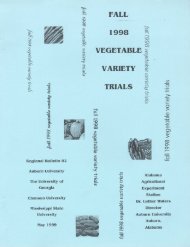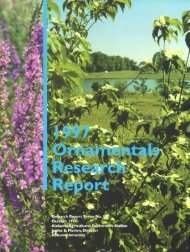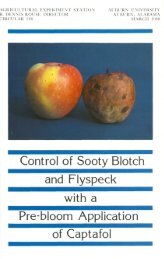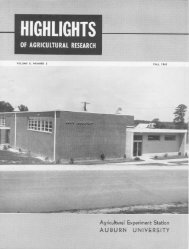MARKETING CHRISTMAS TREES - Auburn University Repository
MARKETING CHRISTMAS TREES - Auburn University Repository
MARKETING CHRISTMAS TREES - Auburn University Repository
You also want an ePaper? Increase the reach of your titles
YUMPU automatically turns print PDFs into web optimized ePapers that Google loves.
24 ALABAMA<br />
AGRICULTURAL EXPERIMENT STATION<br />
CONCLUSIONS<br />
1. There seems little doubt that the Christmas tree business<br />
justifies further attention by potential producers of trees. In Alabama<br />
alone it may, at reported prices, represent about a million<br />
dollar business at retail and half that amount at wholesale.<br />
2. The potential demand for quality, locally produced trees<br />
(well-shaped, full, good color, and without substantial deformities<br />
or defects) is good. It appears to exceed the current supply<br />
of such trees at prices comparable with those of trees of similar<br />
height from distant sources.<br />
3. While tastes for species of Christmas trees vary, a number<br />
of customers who did not buy cedars in 1956 expressed a preference<br />
for them. These buyers can be expected to reconsider their<br />
purchase plans when local trees of satisfactory quality are available<br />
at competitive prices.<br />
4. Usually, a very large percentage of locally grown unsold<br />
trees had such obvious quality weaknesses that they should never<br />
have been harvested.<br />
5. Trees can be protected to preserve quality in the market, but<br />
actual quality improvement must come largely in production.<br />
Tinting, however, will hide certain color defects in otherwise<br />
good trees.<br />
6. Lack of order and organization in harvesting and marketing<br />
Christmas trees appears to be a serious general handicap, particularly<br />
with regard to cedars. That needs to be overcome to increase<br />
their market acceptance.<br />
7. A paramount need in harvesting and marketing is standardization,<br />
grading, and grouping of trees to permit producers, wholesalers,<br />
retailers, and consumers to understand each other when<br />
dealing with and pricing trees.<br />
8. Standardization, grading, grouping, and probably packaging<br />
would be a boon to, if not essential to, moving trees through the<br />
great established mass markets as typified by chain grocery stores.<br />
9. Development of processing, packaging, and grading that<br />
would result in local trees equal in slielf life, ease of handling, and<br />
attractiveness, at prices competitive with those of imported "ornamentals"<br />
might lead to a sharp expansion of sales, especially<br />
among mass sellers.
















